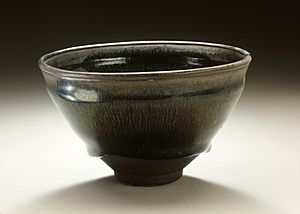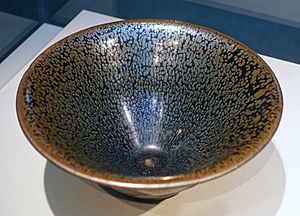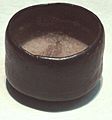Chawan facts for kids
Quick facts for kids Chawan |
|||||||||||||||
|---|---|---|---|---|---|---|---|---|---|---|---|---|---|---|---|

Chawan with hare's fur glaze in mottled black, Jian ware, from Jianyang in Song China
|
|||||||||||||||
| Chinese name | |||||||||||||||
| Chinese | 茶碗 | ||||||||||||||
| Literal meaning | "tea bowl" | ||||||||||||||
|
|||||||||||||||
| Alternate Chinese name | |||||||||||||||
| Traditional Chinese | 茶盞 | ||||||||||||||
| Simplified Chinese | 茶盏 | ||||||||||||||
| Literal meaning | "tea cup" | ||||||||||||||
|
|||||||||||||||
| Korean name | |||||||||||||||
| Hangul | 찻사발, 다완 | ||||||||||||||
| Hanja | n/a, 茶碗 | ||||||||||||||
| Literal meaning | "tea bowl" | ||||||||||||||
|
|||||||||||||||
| Japanese name | |||||||||||||||
| Kanji | 茶碗 | ||||||||||||||
| Kana | ちゃわん | ||||||||||||||
|
|||||||||||||||
A chawan (pronounced "cha-wan") is a special bowl used for making and drinking tea. Many types of chawan are used in East Asian tea ceremonies. The type of chawan chosen depends on many things.
Contents
The Story of Chawan

Chawan bowls first came from China. The first chawan bowls arrived in Japan from China between the 1200s and 1500s.
Famous Chinese Tea Bowls
The Jian chawan was a very popular Chinese tea bowl. In Japan, it was known as Tenmoku chawan. This bowl was the favorite for Japanese tea ceremonies until the 1500s. People in Japan mostly drank tea from these Chinese bowls until about the 1400s.
The Japanese name tenmoku comes from Tianmu Mountain in China. Japanese priests brought these tea bowls back from Chinese temples on that mountain.
In the 1000s, someone from Fujian, China, wrote about the Jian tea bowls. They said that tea looks best in black cups. The cups made in Jianyang were bluish-black and looked like a hare's fur. They were thick, so they kept the tea warm for a long time. People thought these bowls were the best.
Japanese Chawan Styles
As tea drinking became popular across Japan by the late 1300s, many people wanted the Tenmoku chawan. So, the Japanese started making their own copies in Seto. The original Chinese Tenmoku chawan came in different colors and shapes. But the Japanese especially liked the bowls that were tapered (narrower at the bottom). So, most Seto-made Tenmoku chawan had this shape.
Later, a style of tea ceremony called wabi became popular in Japan. This style focused on simplicity and naturalness. Because of this, the Ido chawan became very special. These were Korean bowls, mostly used for rice in Korea. A famous tea master named Sen no Rikyū loved Korean bowls for their simple, rough look.
Over time, the Japanese tea ceremony developed its own unique style. Local Japanese pottery became more valued. By the 1600s, many chawan were made right in Japan.
Some of the most respected types of chawan for tea ceremonies are raku ware, Hagi ware, and Karatsu ware. There's a saying in tea ceremony schools about the best types of chawan: "Raku first, Hagi second, Karatsu third."
Another type of chawan that became a bit popular in Japan during the 1600s was Annan ware from Vietnam. These bowls were originally used for rice there. Annan ware bowls are blue and white with a high base.
How Chawan Are Used
A special cloth called a chakin is used to carefully wipe the chawan clean before and after using it for tea.
Different Kinds of Chawan
Japanese chawan come in many different shapes and types. Many of them have special names:
- "iron" bowl (鉄鉢形, tetsubachi-nari / teppatsu-nari)
- "wooden" bowl (椀形, wan-nari)
- Goki (呉記型, Goki-gata)
- half-cylinder (半筒型, han tsutsu-gata)
- cylinder (筒型, tsutsu-gata)
- go stone box (碁笥底型, gokezoko-gata)
- waist (胴締, dojimari-gata)
- rider's cup (馬上杯 / 馬上盃, bajyohai)
- cedar (杉形, sugi-nari)
- ido / well (井戸型, ido-gata)
- Tenmoku (天目型, Tenmoku-gata)
- Komogai (熊川形, Komogai-nari) – named after a Korean port
- Silver tenmoku (銀天目茶碗, silver tea bowl made in the tenmoku style)
- curving lip (端反り型, hatazori-gata)
- flat (平形, hiragata)
- horse bucket (馬盥, badarai)
- clog/shoe (沓形, kutsu-gata)
- shoreline (砂浜形, suhama-gata)
- peach (桃形, momo-gata)
- brush washer (筆洗形, hissen-gata)
- straw hat (編笠, amikasa)
- triangular (三角形, sankaku-gata)
- four-sided (四方形, shiho-gata)
Images for kids
-
White raku teabowl Fuji-san (Mount Fuji) by Honami Kōetsu, Edo period, 17th century National Treasure
-
Black raku bowl used for thick tea, Azuchi-Momoyama period, 16th century





